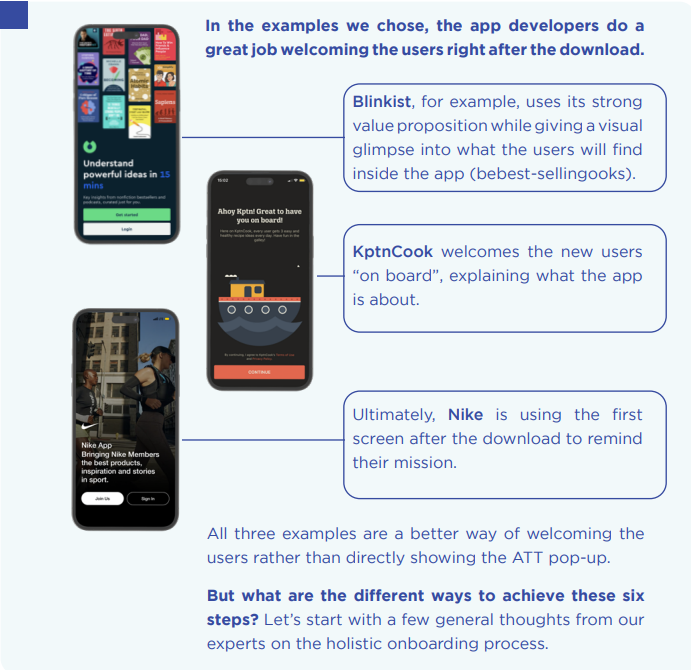Why Mastering Your App User Onboarding Experience in 2023 Is Crucial: Part 2
- Friday, May 26th, 2023
- Share this article:
In the second part of his piece looking at app user onboarding, Lorenzo Rossi, co-founder at REPLUG, looks at personalization and permissions.
 Lets start with the fundamentals. All industry experts agree on one thing: in 2023, the process of onboarding is critical to attracting and keeping customers in your app.
Lets start with the fundamentals. All industry experts agree on one thing: in 2023, the process of onboarding is critical to attracting and keeping customers in your app.
More specifically, experts from the mobile and app industry agree that an effective onboarding process includes the following key elements:
- It should instantly help users comprehend the value of your app, allowing them to quickly outline, define, and utilize your product/app.
- It should successfully let customers become familiar with your apps primary features and USPs, as well as its perks and advantages.
- It should clearly allow users to opt-in to privacy standards and seamlessly leave their log-in information.
- It should be an illustration of your apps brand when it comes to UI and UX.
- At the final stage of the flow, it should act as a convincing experience for customers to pay for the app.
- It should gradually but persistently persuade people to return for more.
Below, you can see some best examples that we at REPLUG wanted to showcase.

On using personalization and welcome messages
A vital first step is to greet your users with an attractive mix of personalization, targeting, and welcoming messaging. Though many apps take various methods, customization can frequently take several forms:
- Localization by country, demographic, or even age
- Targeted messages depending on the user
- Accessible communication and tailored messaging based on your target market
Welcoming messages might also help your user feel appreciated. Receiving the incorrect message as a first impression might majorly affect your users engagement with your app.
However, there is always a beginning. When it comes to personalization or welcoming messages, certain apps do nothing at all. We see it as a huge squandered opportunity.
In addition, a sincere greeting message always goes a long way. Whether you use carefully written copy, a pleasant UX design, or CRM-focused alternatives, the onboarding journey should reflect your brands core values and tone.
1. A chance to outline the apps main features and benefits
After youve personalized and used sensitive messaging, the major features of your product are an important subject to cover in your user onboarding funnel. 72 per cent of users think finishing the app onboarding process in under a minute is a crucial element in their choice to continue using an app, implying that your time is limited.
Explaining USPs, benefits, and vital features throughout the onboarding process can spark your users attention and entice them to return for more.
2. Focus on permissions request structure and increased opt-in
The way you organize opt-in along with additional permission requests is critical to your processes in the request-filled onboarding scenario. Permission and opt-in must be smoothly intertwined throughout the whole onboarding process, from screen sequencing to the precise copy with which you frame requests.
What are the advantages? Users who choose to get notifications are four times more engaged with applications and twice as likely to be retained as those who do not. Another study found that engaged and pleased consumers pay an additional 17 per cent price premium once they opt-in in terms of income and return on investment.

3. An opportunity to prevent unistalls
What about onboarding and uninstalling? In terms of app stores, 80 per cent of consumers delete the app from their smartphones three days after installing it (source: Storyly).
Furthermore, one out of every two apps installed is removed after 30 days (source: Appsflyer). After three months, 5 per cent of the remaining 20 per cent delete the app from their mobile devices, highlighting the importance of knowing why users are leaving.
As a result, uninstalls are an important measure (KPI) for evaluating your onboarding process. Teams are beginning to invest in such data to discover when users are leaving.
4. An effort to align marketing activities to product requirements
One of the most common areas where companies go wrong is the misalignment of the product and marketing branches. Many experts think that none of the abovementioned elements in the onboarding process—personalization, permission structure, USP explanation, and so on—are worth anything if your KPIs or north stars are misaligned.
Its vital to remember that the user cannot see whats going on behind the scenes in the conference room. After all, they just see whats on their screen, not the discussion over screen sequencing or messaging.
Truly, marketing and product teams must be on the same page in order to make the onboarding process as seamless and relevant as possible. Failure to do so might be expensive, both in terms of ROI and overall onboarding approach.
Next to come in User Onboarding Strategy
As we stated multiple times, in 2023, onboarding is hour zero in a mobile app. It is the first time a user comes into contact with your app and gets a sense of what it has to offer.
But what are the fast wins for improving your onboarding process? More importantly, how can you keep your users attention until the final onboarding screen?
In the third part of this app user onboarding series, we will cover different onboarding strategies. By then, be sure to download our ebook on this topic.
Find every crucial information for a successful user onboarding. From best practices, examples, and industry experts’ quotes – get the free ebook now.
And if you are trying to track your results but arent sure if you are doing it the right, check out our free tracking and MMP setup checklist.















